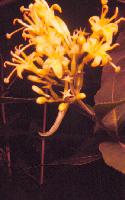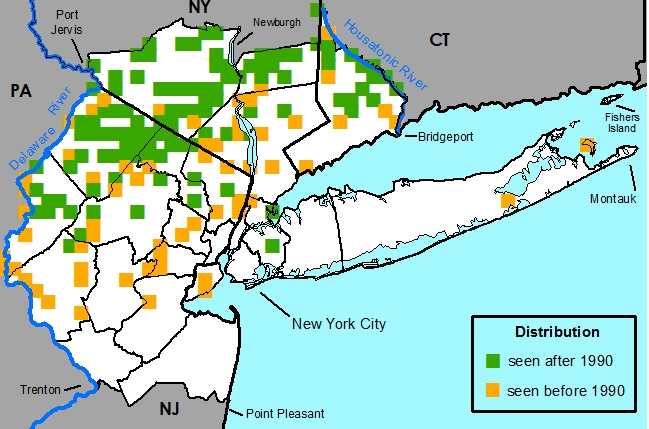Diervilla lonicera Mill. - Bush Honeysuckle


Common Names
Bush HoneysuckleField Identification
Small (to 1.5 m), rhizomatous, opposite-leaved shrub with clusters of light-yellow flowers near twig ends; fruits elongate with persistent, star-shaped appendages on tips.Medicinal uses
Disclaimer: The information provided here is for reference and historical use. We do not recommend nor do we condone the use of this species for medicinal purposes without first consulting a physician.
Used by native Americans to treat stomach pains, constipation, urinary difficulties, gonorrhea, sore eyes, senility, vertigo, and as a diuretic, blood medicine, and given to "spoiled babies with adulterous mother."
Nomenclature
Diervilla lonicera Mill., Gard. Dict. Ed. 8. 1768.*Lonicera diervilla L., Sp. Pl. 175. 1753.
Diervilla canadensis Bartram, Cat. Am. Trees Bartram’s Gard. broadsheet, col. 3. [1785 vel prius] “Diarvilla”
nom.
Diervilla trifida Moench, Methodus. 492. 1794; Gray, Syn. Fl. N. Am. 1,2: 18. 1884.
Diervilla tourneforti Michx., Fl. Bor.-Am. 1: 107. 1803.
Diervilla humilis Persoon, Syn. Pl. 1: 214. 1805.
Diervilla canadensis Willdenow, Hort. Berol. 1: 222. 1806.
Diervilla lutea Pursh, Fl. Am. Sept. 1: 162. 1814.
Diervilla acadiensis Duhamel ex Baillon, Nat. Hist. Pl. 7: 352, fig. 356. 1880.
Diervilla diervilla MacMillan, in Bull. Torrey Bot. Club. 19: 15. 1892.
TYPE: unknown
Diervilla lonicera var. hypomalaca Fern. Rhodora 42:144. 1940.
TYPE: unknown
Description
HABIT Perennial, deciduous, phanerophytic, shrub, monoclinous, 0.5-1.5 m tall, stoloniferous.STEMS Main stems ascending or erect, round. Bark not exfoliating. Branches erect or ascending or horizontal. Twigs dark red or light orange-red or brown or gray, terete, 2-4 mm in diam., smooth, glabrous or with short and unbranched, erect or spreading, white hairs. Current year twigs with minute pilose rows decurrent from nodes; 2nd+ year twigs glabrous. Pith white, round, continuous; nodal diaphragm absent. Sap translucent.
BUDS Terminal and axillary present, scattered along stem; pointed; axillary buds 1 per axil. Bud scales imbricate, membranaceous, with long and unbranched, appressed, white, hairs; moderately densely distributed apically. Bud scale scars not encircling the stem. Leaf scars crescent-shaped with 3 bundle traces.
LEAVES Simple, opposite, 2 per node, spaced somewhat evenly along and divergent from stem. Stipules absent. Leaves petiolate; petiole furrowed, 0.2-0.8 cm long, with short and long erect to spreading unbranched hairs, sparsely to densely distributed throughout. Leaf blades: oblong or ovate, bilaterally symmetric, 3-13 cm long, 2-6 cm wide, base obtuse, margin serrulate and ciliate, apex acuminate; abaxial surface light green, glabrous or with long and unbranched spreading hairs, sparsely distributed mostly along midveins. Adaxial surface green, glabrous or with short and unbranched hairs, sparsely distributed mostly along midveins; arcuate veination. Note: var. hypomalaca found in the upper Midwest and adjacent Canada, has dense white pilosity on abaxial surface.
INFLORESCENCES Serotinous, formed on the current season's growth, bisexual, cyme or compound cyme, terminal or axillary. Peduncle 0.5-1.5 cm long. Bracts green, often streaked and spotted with red, linear triangular, 2-6 mm long, 0.5 mm wide, margin ciliate, apex acute, abaxial surface glabrous, adaxial surface glabrous. Pedicels 3-10 mm long, glabrous or with short and unbranched spreading white hairs, sparsely distributed throughout. Bracteoles 2, at apex of pedicel, green, often streaked and spotted with red, linear triangular, 2-6 mm long, 0.5 mm wide, margin ciliate, apex acute, surfaces glabrous.
FLOWERS 5-merous, perianth of two whorls with sepals and petals readily distinguishable from one another, 20-30 mm long, 15 mm wide, weak fragrance present. Calyx actinomorphic, of free sepals, persistent, abaxial and adaxial surfaces green. Sepals 5, linear triangular, 3-7 mm long, 0.5 mm wide, margin ciliate, apex acute, abaxial surface glabrous, often streaked and spotted with red. Corolla zygomorphic, bilabiate, of fused petals with 5 lobes, deciduous, abaxial and adaxial surfaces light yellow, turning darker, often red, after anthesis; outer surface of lower corolla tube sparsely to moderately puberlent; nectary at base. Margin of lobes entire, apex obtuse, abaxial surface glabrous, adaxial surface with long and unbranched hairs. Gynoecium syncarpous. Locules 2. Stigma 1, capitate. Styles 1, hispid, exserted. Ovary inferior, elongate, glabrous. Placentation parietal. Stamens 5, epipetalous, exserted. Anthers dehiscing along the long axis, light yellow, glabrous. Filaments straight, proximally hispid. For a morphological survey of pollen see Donoghue, 1985. For a detailed analysis of the flower micro-anatomy see Wilkinson, 1948.
FRUITS Septicidal capsule, brown, 7-10 mm long, 3-4 mm wide, glabrous, crowned with persistent calyx.
SEEDS Brown, globose, 1-1.5 mm long, 1 mm wide, glabrous, reticulate-foveate.
Habitat
In the NYMF area, usually in dry to mesic well drained or rocky woods, banks, ledges; farther north, found in open and sandy thickets, woodlands, jack pine plains, and dry ground that has been cleared or burned within the past 30 to 50 years.
Distribution
Indigenous to eastern North America.United States -- CT, DE, IA, IL, IN, KY, MA, MD, ME, MI, MN, NC, NH, NJ, NY, OH, PA, RI, TN, VA, VT, WI, WV
Canada -- NB, NF, NS, ON, PE, QC, SK
New York Metropolitan Region -- Native, predominantly in the north and northwestern areas of our flora.
Rarity Status
Heritage Global Rank -- G5Connecticut -- Not listed
New Jersey -- Not listed
New York -- Not listed
Species Biology
Flowering May [week 4] - July [week 2] (with sporadic flowering into September [week 3])Pollination
Melittophily – Anthophora terminalis furcata, Bombus affinis, Bombus terricola, Bombus vagans, Dialictus laevissimus, Dialictus lineatulus, Megachile addenda, Megachile inermis
Phalaenophily – Hemaris diffinis
Fruiting fruits often persistent throughout year
Dispersal unknown
Germination
Recent studies suggest large portion (85%) of seeds have only morphological dormancy and germinated within 30 days in moist, warm soil. The other 15% have morphophysiological dormancy and require a period of warm stratification or treatment of GA3 to break dormancy. Light is critical for germination regardless of dormancy or treatments.